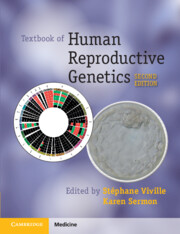Book contents
- Textbook of Human Reproductive Genetics
- Textbook of Human Reproductive Genetics
- Copyright page
- Contents
- Contributors
- Chapter 1 Basic Genetics and Cytogenetics: A Brief Reminder
- Chapter 2 Application of Whole-Genome Technologies to Assisted Reproductive Treatment
- Chapter 3 Meiosis: How to Get a Good Start in Life
- Chapter 4 Chromosomes in Early Human Embryo Development: Incidence of Chromosomal Abnormalities, Underlying Mechanisms, and Consequences for Diagnosis and Development
- Chapter 5 DNA Is Not the Whole Story: Transgenerational Epigenesis and Imprinting
- Chapter 6 Genes Are Not the Whole Story: Retrotransposons as New Determinants of Male Fertility
- Chapter 7 Chromosomal Causes of Infertility
- Chapter 8 Genetics of Human Male Infertility: The Quest for Diagnosis and Treatment
- Chapter 9 Genetics of Human Female Infertility
- Chapter 10 Preconception Genetics Analysis/Screening in IVF
- Chapter 11 Genetic Counseling in Assisted Reproductive Treatment
- Chapter 12 Mitochondrial Genetics in Reproductive Medicine
- Chapter 13 Preimplantation Genetic Testing
- Chapter 14 Epigenetics and Assisted Reproductive Technology
- Chapter 15 Human Reproductive Genetics in Medically Assisted Reproduction: Ethical Considerations
- Index
- References
Chapter 5 - DNA Is Not the Whole Story: Transgenerational Epigenesis and Imprinting
Published online by Cambridge University Press: 15 December 2022
- Textbook of Human Reproductive Genetics
- Textbook of Human Reproductive Genetics
- Copyright page
- Contents
- Contributors
- Chapter 1 Basic Genetics and Cytogenetics: A Brief Reminder
- Chapter 2 Application of Whole-Genome Technologies to Assisted Reproductive Treatment
- Chapter 3 Meiosis: How to Get a Good Start in Life
- Chapter 4 Chromosomes in Early Human Embryo Development: Incidence of Chromosomal Abnormalities, Underlying Mechanisms, and Consequences for Diagnosis and Development
- Chapter 5 DNA Is Not the Whole Story: Transgenerational Epigenesis and Imprinting
- Chapter 6 Genes Are Not the Whole Story: Retrotransposons as New Determinants of Male Fertility
- Chapter 7 Chromosomal Causes of Infertility
- Chapter 8 Genetics of Human Male Infertility: The Quest for Diagnosis and Treatment
- Chapter 9 Genetics of Human Female Infertility
- Chapter 10 Preconception Genetics Analysis/Screening in IVF
- Chapter 11 Genetic Counseling in Assisted Reproductive Treatment
- Chapter 12 Mitochondrial Genetics in Reproductive Medicine
- Chapter 13 Preimplantation Genetic Testing
- Chapter 14 Epigenetics and Assisted Reproductive Technology
- Chapter 15 Human Reproductive Genetics in Medically Assisted Reproduction: Ethical Considerations
- Index
- References
Summary
There are two types of genomic information accurately inherited or maintained following DNA replication: the entire genomic DNA sequence and epigenetic information in the form of patterns of CpG methylation on a subset of the genome. These DNA methylation patterns are crucially important for mammalian development, primarily because they regulate gene transcription. There are cyclical declines and increases in DNA methylation during gametogenesis and embryogenesis, and the oscillations in methylation occurring across generations must depend on de novo methylation and demethylation processes to rearrange the existing methylation patterns. Within any single reproductive cycle, changes in genomic methylation are the outcome of a linked sequence of active and passive processes that rearrange genomic methylation to generate epigenetic milestones, each with a defined future role. For example, genomic imprints are established during gametogenesis by de novo methylation to generate mature gametes with complete complements of paternal methylation imprints in sperm and maternal methylation imprints in oocytes. The establishment of a collective set of imprints within a sperm and an oocyte is an epigenetic milestone, whose purpose after sperm–oocyte fusion is to ensure monoallelic expression of imprinted genes during fetal development. We postulate that another essential epigenetic milestone is found in the blastocyst-stage embryo; this milestone is achieved at the generation, through the poorly understood process of epigenetic reprogramming, of pluripotent embryo stem cells, whose role is to contribute to the development of the conceptus. Primordial germ cells (PGCs), largely devoid of genomic methylation and poised to differentiate into gametes with sex-specific imprints, and adult stem cells, poised to differentiate into organs, would be other possible epigenetic milestones. The developmental locations of three fundamental milestones (gametes, blastocyst, and PGCs), and the epigenetic processes by which they are crafted, are depicted in Figure 5.1.
- Type
- Chapter
- Information
- Textbook of Human Reproductive Genetics , pp. 68 - 82Publisher: Cambridge University PressPrint publication year: 2023

